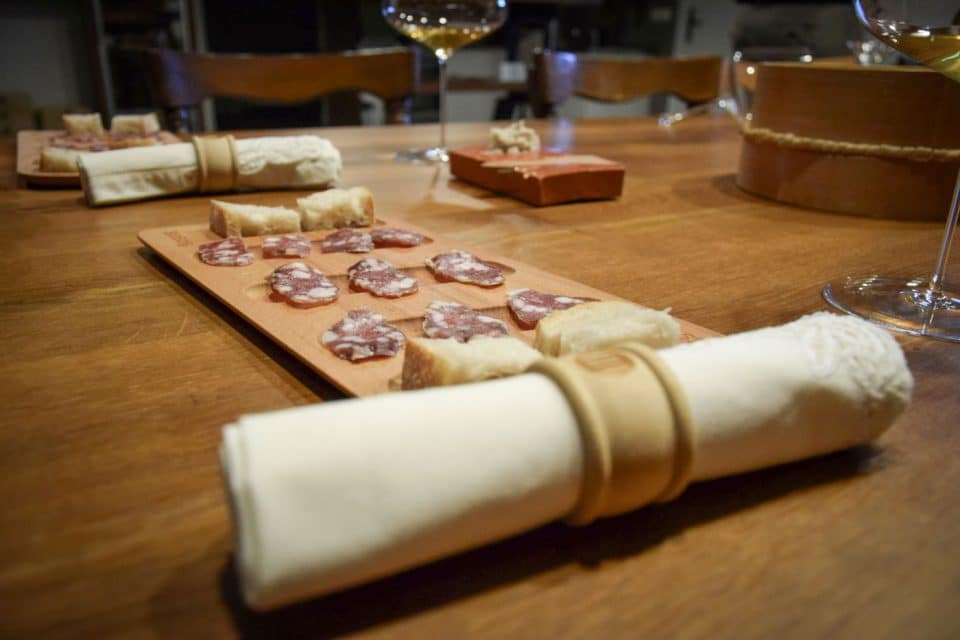Slovenia, nestled in the heart of Europe, is a treasure trove of culinary specialties, a major slice of which is the rich tradition of sausages and cured meats.
From the verdant landscapes dotted with farms, or kmetiji, to the lively food markets of Ljubljana, Slovenia offers a diverse array of sausages and cured meats, including salamis. forming a significant part of the local diet, it’s no surprise these delicacies immediately come to mind when one thinks of Slovenian cuisine.
Slovenia’s Culinary Gems: Famous Sausages and Cured Meats
Slovenia boasts a variety of sausages and cured meats. Here are some notable examples.
Kranjska Klobasa
Also known as Carniolan sausage, this iconic Slovenian delicacy is crafted from pork and seasoned with a blend of garlic, salt, pepper, and spices. Renowned for its distinctive flavor, Kranjska klobasa is enjoyed grilled or boiled.
The quality of this sausage has often been certified. Most notably, Rozman, a butcher’s shop in Ljubljana, received a prestigious gold medal for its Carniolian sausage at the 1932 Brussels World Exhibition of Food Products.
Pršut
Slovenian pršut is a type of dry-cured ham similar to Italian prosciutto (here’s more on Italian cured meats). It is typically made from pork leg that is salted and air-dried for several months to develop its rich flavor and delicate texture. Pršut is usually thinly sliced and served as an appetizer or part of a charcuterie board.
Klobasa
In addition to Kranjska klobasa, Slovenia produces a variety of other sausages, collectively referred to as klobasa. These sausages come in different shapes, sizes, and flavors, depending on the region and local traditions. They are commonly made from pork and seasoned with a blend of spices. One example is krvavica, or blood sausage, made from a mixture of pork meat, pork blood, and spices.
Klobase
Similar to klobasa, klobase are smoked sausages popular in Slovenian cuisine. They are typically made from a mixture of pork and beef, seasoned with garlic, pepper, and other spices, and then smoked to enhance their flavor. Klobase are often enjoyed grilled or served with sauerkraut.
Kraška Klobasa (Karst Sausage)
Hailing from the Karst region of Slovenia, the Karst sausage is a traditional dry-cured sausage with a slightly spicy flavor. It is made from high-quality pork and seasoned with garlic, pepper, and other spices before being air-dried for several weeks to develop its distinctive taste.
The Art of Meat Preservation in Slovenia: Tradition Meats Innovations
As in other parts of the world, the tradition of curing meats in Slovenia, including sausages and salamis, emerged from the need to preserve perishable meats. When refrigeration was not readily available, families relied on techniques such as salting, drying, and seasoning to ensure their meat lasted for extended periods.
While time-honored, traditional practices remain prevalent, some Slovenian producers embrace innovation, incorporating modern technologies and techniques into the production of sausages and cured meats.
In the quaint old town of Ribnica, just a stone’s throw from the capital, Ljubljana, lies a hidden gem: the BioSing Salami Cellar. Here, amidst the town’s historical roots, David Lesar crafts exquisite salamis that express both tradition and innovation.
The town itself has a long history of processing and selling timber products, since well back in the 14th century. Steeped in tradition, it was the perfect place for David Lesar’s vision, encapsulated in the name BioSing (Bio Salami Engineering), for designing a product using age old techniques, carefully selected raw materials, and with attention to detail right down to the final tasting experience. The company offers a range of products, including aged salamis and specialty items like deer and bear salami, which are aged for up to 10 years.
What sets BioSing apart is not just the taste but the meticulous craftsmanship that goes into each salami. Firstly, the meat is not ground, but diced. Once the salami is prepared, it is partly smoked using beechwood then slowly cooled underground, giving it a subtle aroma. To mature, the salami is placed in specially ventilated clay chambers, allowing noble molds to release lipolytic and proteolytic enzymes, creating a supremely delicate, distinctive taste.
This is what sets BioSing apart. Many salamis rely on over salting for their taste. For BioSing, it is the art of long fermentation, the addition of wine and cognac, and loving care that create a uniquely special taste.


Boutique Salamis
As well as BioSing, Slovenia has several other boutique salami producers known for their high-quality and artisanal approach to crafting cured meats.
Klobasarna Carniola, for example, located in Ljubljana, is renowned for its traditional Carniolan sausages. Another is Kras, a boutique producer based in the Karst region of Slovenia, with origins that go back to the 1950s. They specialize in dry-cured meats, including salami and prosciutto, using traditional methods and locally sourced ingredients.
Culinary Heritage
Slovenian sausages and cured meats are an integral part of the country’s culinary heritage. They embody the values of craftsmanship, community, and sustainability, preserving not only the flavors of the past but also the stories and traditions of past generations.
Related: Most Popular Slovenian Dessert Recipes
The post Slovenian Sausages & Cured Meats: Tradition & Innovation appeared first on Chef's Pencil.
from Chef's Pencil https://ift.tt/YmfnU5q
via https://chefsspenncil.blogspot.com

No comments:
Post a Comment